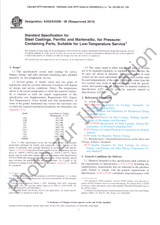Wir benötigen Ihre Einwilligung zur Verwendung der einzelnen Daten, damit Sie unter anderem Informationen zu Ihren Interessen einsehen können. Klicken Sie auf "OK", um Ihre Zustimmung zu erteilen.
ASTM E165/E165M-18
Standard Practice for Liquid Penetrant Testing for General Industry
Name übersetzen
NORM herausgegeben am 15.11.2018
Informationen über die Norm:
Bezeichnung normen: ASTM E165/E165M-18
Anmerkung: UNGÜLTIG
Ausgabedatum normen: 15.11.2018
SKU: NS-910863
Zahl der Seiten: 19
Gewicht ca.: 57 g (0.13 Pfund)
Land: Amerikanische technische Norm
Kategorie: Technische Normen ASTM
Kategorie - ähnliche Normen:
Die Annotation des Normtextes ASTM E165/E165M-18 :
Keywords:
fluorescent liquid penetrant examination, hydrophilic emulsification, lipophilic emulsification, liquid penetrant examination, nondestructive examination, solvent removable, visible liquid penetrant examination, water-washable, post-emulsified, ultraviolet light, UV-A, visible light,, ICS Number Code 19.100 (Non-destructive testing)
Ergänzende Informationen
| Significance and Use | ||||||||||||||||||||||||||||||||||||||||||||
|
5.1 Liquid penetrant testing methods indicate the presence, location and, to a limited extent, the nature and magnitude of the detected discontinuities. Each of the various penetrant methods has been designed for specific uses such as critical service items, volume of parts, portability, or localized areas of examination. The method selected will depend accordingly on the design and service requirements of the parts or materials being tested. |
||||||||||||||||||||||||||||||||||||||||||||
| 1. Scope | ||||||||||||||||||||||||||||||||||||||||||||
|
1.1 This practice2 covers procedures for penetrant examination of materials. Penetrant testing is a nondestructive testing method for detecting discontinuities that are open to the surface such as cracks, seams, laps, cold shuts, shrinkage, laminations, through leaks, or lack of fusion and is applicable to in-process, final, and maintenance examinations. It can be effectively used in the examination of nonporous, metallic materials, ferrous and nonferrous metals, and of nonmetallic materials such as nonporous glazed or fully densified ceramics, as well as certain nonporous plastics, and glass. 1.2 This practice also provides a reference: 1.2.1 By which a liquid penetrant examination process recommended or required by individual organizations can be reviewed to ascertain its applicability and completeness. 1.2.2 For use in the preparation of process specifications and procedures dealing with the liquid penetrant testing of parts and materials. Agreement by the customer requesting penetrant testing is strongly recommended. All areas of this practice may be open to agreement between the cognizant engineering organization and the supplier, or specific direction from the cognizant engineering organization. 1.2.3 For use in the organization of facilities and personnel concerned with liquid penetrant testing. 1.3 This practice does not indicate or suggest criteria for evaluation of the indications obtained by penetrant testing. It should be pointed out, however, that after indications have been found, they must be interpreted or classified and then evaluated. For this purpose there must be a separate code, standard, or a specific agreement to define the type, size, location, and direction of indications considered acceptable, and those considered unacceptable. 1.4 Units—The values stated in either SI units or inch-pound units are to be regarded separately as standard. The values stated in each system may not be exact equivalents; therefore, each system shall be used independently of the other. Combining values from the two systems may result in non-conformance with the standard. 1.5 This standard does not purport to address all of the safety concerns, if any, associated with its use. It is the responsibility of the user of this standard to establish appropriate safety, health, and environmental practices and determine the applicability of regulatory limitations prior to use. 1.6 This international standard was developed in accordance with internationally recognized principles on standardization established in the Decision on Principles for the Development of International Standards, Guides and Recommendations issued by the World Trade Organization Technical Barriers to Trade (TBT) Committee. |
||||||||||||||||||||||||||||||||||||||||||||
| 2. Referenced Documents | ||||||||||||||||||||||||||||||||||||||||||||
|
Empfehlungen:
Aktualisierung der technischen Normen
Wollen Sie sich sicher sein, dass Sie nur die gültigen technischen Normen verwenden?
Wir bieten Ihnen eine Lösung, die Ihnen eine Monatsübersicht über die Aktualität der von Ihnen angewandten Normen sicher stellt.
Brauchen Sie mehr Informationen? Sehen Sie sich diese Seite an.




 Cookies
Cookies
